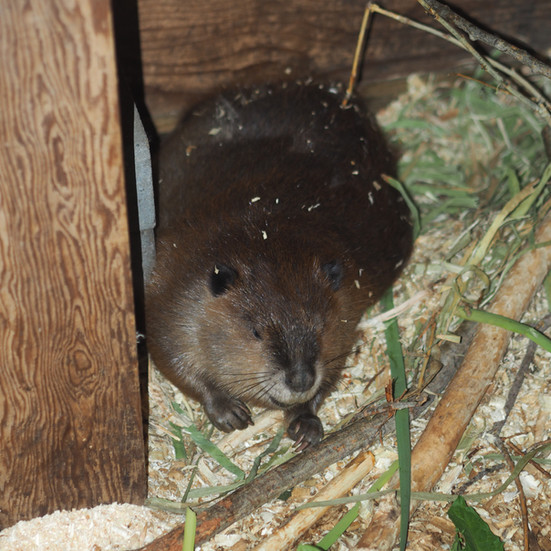Patient Update: Beaver Recovery Sparks Ecosystem Renewal
- Calgary Wildlife

- Aug 13
- 4 min read
Updated: Aug 14
On March 11, 2024, a young adult beaver was found injured near the river in Calgary’s downtown East Village. Beavers are highly territorial animals, and with limited natural habitat available in such a dense urban environment, it's likely there was no suitable territory left for her to establish herself. This may have contributed to her injury and disorientation. While she had reached the life stage where beavers begin seeking out new territory, her condition suggested she was in need of care and support.
Calgary Wildlife responded swiftly, bringing her to our facility—the only accredited wildlife hospital within the city of Calgary, and one of the few in Alberta equipped to provide advanced, species-specific care to native wildlife. With multiple decades of experience rehabilitating beavers and a team that includes staff with backgrounds in Association of Zoos and Aquariums (AZA) and Canadian Association of Zoos and Aquariums (CAZA) accredited facilities and aquatic species care, our team is exceptionally well-equipped to support these keystone species through every stage of recovery. Leading the release project was Melanie Whalen, our Director of Wildlife Care and Services. With a certification as a Beaver Wetland Specialist through the Beaver Institute, one of only three certified in Alberta, Melanie brings a rare and valuable skill set to our team. She developed a tailored care plan that addressed the unique behavioural and ecological needs of this keystone species. The Calgary Wildlife team provided appropriate medical treatment, specialized nutrition, and a recovery setting that supported the young beaver’s eventual return to the wild.
After 133 days of dedicated care, she was ready for release. In Alberta, relocating beavers is typically prohibited under provincial regulations due to concerns about disease transmission, habitat disruption, and inter-colony conflict. However, because this beaver was admitted with injuries and required rehabilitation, her release into a suitable, unoccupied habitat was approved, making this a rare and exceptional case. Returning her to where she was found was not an option, so a more appropriate location was carefully selected.
On July 22, 2024, she was released at Screwdriver Creek, northwest of Beaver Mines, Alberta. This location had not seen beaver activity for over three decades, during which time water quality declined and fish and bird populations suffered. With no resident beavers and a clear need for ecological renewal, the site offered an ideal opportunity for reintroduction. As a healthy young adult with the skills to survive independently, she was not only ready for release—she was uniquely positioned to kickstart the recovery of a long-degraded watershed.
Her release marked not just the end of her rehabilitation, but the beginning of a hopeful new chapter: for her, and for a landscape long in need of renewal.
One Year Later
On June 9, 2025, almost a year after her release, our team revisited Screwdriver Creek in Beaver Mines to evaluate her progress, and the improvements were remarkable. Although we didn’t catch a glimpse of her during our visit, the signs were unmistakable: fresh dam-building activity, widened waterways, and rejuvenated flow. Since no other beavers are known to inhabit the area, we feel confident that the transformation of the landscape is her doing. Previously degraded, the area now shows promising signs of ecosystem recovery.
Beavers, known as ecosystem engineers, have an extraordinary ability to reshape landscapes. By building dams and lodges, they slow water flow and create wetlands that act as hubs of biodiversity. These wetlands filter pollutants, recharge groundwater tables, and provide critical habitat for amphibians, fish, birds, and countless invertebrates. Their work also helps mitigate the impacts of drought by holding water on the landscape and reducing erosion. Beaver ponds even serve as natural firebreaks, slowing the spread of wildfires in dry conditions and making surrounding ecosystems more resilient to climate extremes.
Screwdriver Creek is a tributary of the Castle River, contributing to its flow as part of a broader headwater system. The Castle River runs through Castle Wildland Provincial Park, a protected area established in 2017 specifically to support biodiversity and safeguard critical headwaters in southern Alberta. This river system ultimately empties into the Oldman River Reservoir and supplies water to downstream communities such as Fort Macleod and Lethbridge. Historically, Screwdriver Creek contributed to this flow, but in recent years, due to ongoing drought conditions and the absence of beavers, the creek would often run dry before reaching the Castle River.
With the re-establishment of beaver activity in the area, that natural connection is beginning to return. By slowing water and increasing retention, the wetlands she helped restore now play a crucial role in recharging groundwater, supporting more consistent stream flow during dry periods, and acting as natural buffers against both drought and wildfire. The renewed presence of a beaver in this upper watershed is a small but powerful step toward restoring hydrological stability and ecological health, not just for the wild, but for the people who depend on it.
If you see a beaver that appears injured, stranded, or in distress, contact Calgary Wildlife as soon as possible. Our trained staff can assess the situation and ensure the animal gets the care it needs. Whether it’s a beaver in an unusual location, separated from water, or showing signs of injury, we’re here to help. Together, we can ensure these vital animals continue to thrive in Alberta’s landscapes. Call our Wildlife Hotline at 403-214-1312 or visit calgarywildlife.org for more information.






